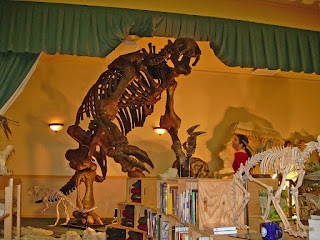
Today's
Science sees the publication of an article about giant fish. Fish bigger than a bus. A friend of mine, Jeff Liston of Glasgow University's
Hunterian Museum, is one of the authors. He has long been obsessed with
Leedsichthys, a fish from the Middle Jurassic which seemed a bit of an anomaly - a monster from an extinct family called Pachycormidae. Most of these were armed with nasty, pointy teeth indicating scary, bitey predation.
Leedsichthys, though, were the teddy bears of the family - suspension feeders, eating plankton. When fully grown they were at least 9 metres long, longer than a double decker, and while estimates based on scaling up from incomplete specimens vary greatly, Jeff is confident in one sample showing at least a length of 16.5 metres.
When I say Jeff's obsessed, I mean it. If there weren't some 160 million years separating the two, there would likely be some sort of inter-species restraining order in place. In his defence, Leedsichthys is an interesting sea-beastie. For a while it stood out, as there seemed to be little else in any way similar. The fossil record showed a 20 million year window where these enormous planktivores popped up then disappeared. Jeff was part of a group of palaeontologists that trawled through old international collections looking to paint in some more of the picture. A first clue came from a discovery by Dave Martill, of Portsmouth University. He had found what he thought might be a juvenile Leedsichthys, from the same Peterborough locality, but which eventually proved to be a new species. It was named Martillichthys. While only around 2 metres long, it showed Big Leedsy at least had a friend and sidekick in the plankton-scooping business.
Examination of private and museum collections, and a bit of extra preparation, turned up a few more examples of this type of fish, previously misidentified. An as yet unidentified pachycormid skull predates the Peterborough material slightly. A skull of a Rhinconichthys from the Upper Cretaceous of Kent dragged the family into the next Period, and a similar fish from Japan was around at a similar time.
Recently, a fish found in Kansas and thought to be a sort of 5m long toothy swordfish was re-identified as another suspension feeding pachycormid and given the name Bonnerichthys. This had been found in deposits from the Late Cretaceous, stretching the existence of this type of large planktivore to only 65 million years ago and the same extinction event that offed the dinosaurs. These animals now have a range in history of around 100 million years, and look like a bit of a success story rather than the evolutionary blip poor, lonely Leedsichthys had once seemed.
After the Cretaceous extinction, though, bony fish haven't returned to fill this empty ecospace. Instead the job of massive, floating krill-sieve has ended up in the capable (erm) hands of whales - mammals, as you may already know - and cartilaginous fish like the whale shark, the basking shark and the manta ray. They're all great animals, obviously, but it would be good to have some of the past masters back, too. There's plenty of room in the sea.
The picture at the top is an almost exclusive to this blog. Impressive, that, isn't it? Almost exclusive... It's a fantastic reconstruction of
Leedsichthys put together by Jeff and fossil artist
Bob Nicholls. Click on his name to visit his site. It's worth it.




